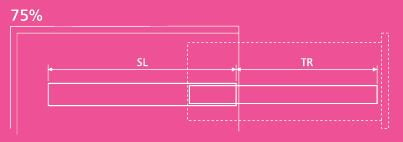Telescopic slides are slides that can be extended telescopically from their closed position to a longer, open position. This type of slide is often used when access to something (for example the contents of a drawer) is required. Since ball bearings are usually located between the slide elements, these slides require only a low moving force even at maximum load.
Telescopic slides are further divided into two types: Partial extension and full extension.
Partial extension rails consist of 2 slide elements and can be extended by up to 75% of the closed length. Full-extension slides, on the other hand, consist of 3 rail elements and can be pulled out 100%. Thanks to the longer pull-out (or pull-out travel), full-extension slides offer better, easier access.



With linear slides, a short inner profile or carriage moves in a closed slide. Linear slides are mostly used in applications where exact movement is more important than easy access. Linear slides are more effective when the load is centered on the carriage. If the load is not centered, the load value can be significantly reduced due to the small length of the carriage and the torque load acting on it.
Read more about the different types of linear slides here.
